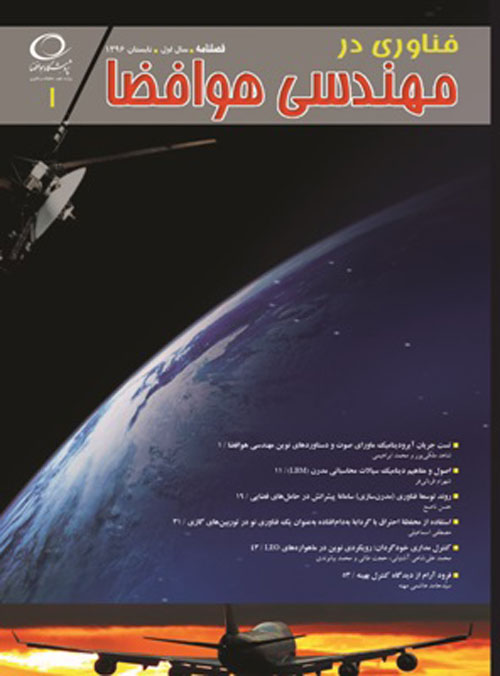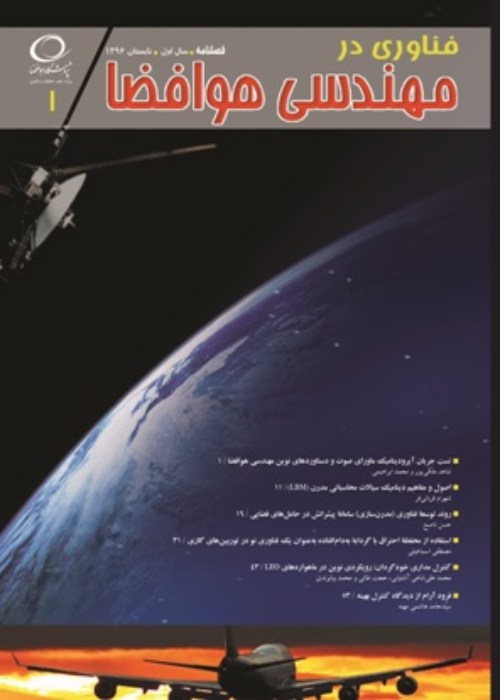فهرست مطالب

نشریه فناوری در مهندسی هوافضا
سال سوم شماره 4 (پیاپی 11، زمستان 1398)
- تاریخ انتشار: 1399/04/23
- تعداد عناوین: 6
-
-
صفحات 1-10هدف این مقاله بررسی فناوری هیدرودینامیک مغناطیسی در ایجاد زلزله های مصنوعی است. برای این منظور، ابتدا به امکان بیان مکانیزم الکتروجنبشی برای زلزله های مصنوعی پرداخته شده است. سپس، عملکرد سیستم ایجاد این زلزله ها و تاثیر آن با استفاده از این فناوری بررسی شده است. همچنین، کاربرد این نوع زلزله های مصنوعی تشریح شده است. در ادامه، با استفاده از تجربیات میدانی و آزمایشگاهی، به نتایجی درخصوص تخلیه تنش های تکتونیکی با پالس های الکتریکی پرقدرت برای کاهش خطرات زلزله اشاره شده است. پس از آن، این فناوری و نحوه عملکرد آن توصیف و در ادامه مقدار تنش های تکتونیکی پوسته زمین و تخلیه آن ها با استفاده از ژنراتور قدرت بالای هیدرودینامیک مغناطیسی و یافتن گسل های جدید اندازه گیری شده است. در انتها، نمونه ای از ایجاد زلزله مصنوعی با استفاده از این روش توصیف و بررسی شده است.کلیدواژگان: هیدرودینامیک مغناطیسی، زلزله مصنوعی، تنش تکتونیکی، گسل زلزله
-
صفحات 11-24
فضاپیماها، مانند راکت ها، ماهواره ها و کاوشگرهای فضایی، راکت های کوچکی برای کنترل مانورها و زاویه دید به نام تراسترها دارند. این تراسترها با خروج گاز از نازل خود نیرو (تراست) ایجاد می کنند. کاهش مصرف پیشرانه، بهبود عملکرد، جابجایی ایمن و هزینه کم ملزومات تراسترهایی می باشد که برای مانور و کنترل زاویه دید ماهواره ها استفاده می شود. به همین دلیل، سامانه های کنترل واکنشی به سمت استفاده از پیشرانه های جدید (پیشرانه های سبز) به جای پیشرانه های سمی حرکت می کند. انواع مختلفی از پیشرانه های سبز تولید شده که به دلایلی مانند قابلیت انبارداری پایین، ایمپالس ویژه کم و چگالی کم مورد استفاده قرار نگرفته اند. هیدروژن پراکساید، نیتروز اکساید، هیدروکسیل آمونیوم نیترات، هیدرازینیوم نیتروفرمات و آمونیوم دی نیترامید پیشرانه های سبزی هستند که مورد تایید بسیاری از ارگان ها قرار گرفته و از آن ها در تراسترهای فضایی استفاده شده است. این مقاله با معرفی اجمالی انواع تراسترها، پیشرانه های سبز استفاد شده را مقایسه نموده، بهترین گزینه را پیشنهاد می کند.
کلیدواژگان: تراستر، پیشرانه سبز، تراسترهای الکتریکی، پیشرانه های تک جزئی، پیشرانه های جامد مرکب سبز، پیشرانش فضایی -
صفحات 25-34
در این مقاله به بررسی نحوه پیاده سازی و اجرای ماژول FRTO از طرح جامع ASBU که جدیدترین و آخرین سند هوانوردی ایکایو برای کمک به رفع نیاز های آتی صنعت هوانوردی و افزایش ظرفیت های عملیاتی با هدف بالا بردن ایمنی، صرفه اقتصادی و ظرفیت مسیر های هوایی است، پرداخته شده است. هدف از اجرای این ماژول استفاده بهینه از فضای پروازی در کشور ایران و منطقه خاورمیانه می باشد. بنابراین، در بخش دوم این مطالعه زیر ساخت های ناوبری مورد نیاز را تشریح و سپس اقدامات لازم جهت اجرایی شدن این ماژول از دیدگاه PBN در TMA تهران مورد بررسی قرار گرفته است.
-
صفحات 35-44
در این مقاله کنترل بهینه یک وسیله هوایی با در نظر گرفتن دینامیک جسم پرنده به همراه مدلسازی موتور پیشران هوازی و بازخورد سرعت آن مورد مطالعه قرار گرفته است. بدین منظور، ابتدا معادلات دینامیکی وسیله هوایی استخراج و مدل ریاضی موتور رانش بدست آمده است. سپس، معادلات دینامیک غیرخطی وسیله پرنده و معادلات موتور با یکدیگر ترکیب شده است. با بیان معادلات دینامیکی خطی سازی شده در فضای حالت، فرمولاسیون کنترل بهینه خطی با معادلات قیدی دینامیک سیستم در نظر گرفته شده و تابع هزینه کمینه انرژی بدست آمده است. با حل مسئله کنترل بهینه خطی، شبیه سازی های متنوعی ارایه شده است. نتایج بدست آمده نشان می دهد که با در نظر گرفتن شرایط اولیه مختلف و عدم قطعیت در مدلسازی سیستم، کنترل بهینه سیستم به خوبی انجام شده است. توجه شود که اثر تغییر ضرایب وزنی مسئله کنترل بهینه بر مسیر کنترلی و بهینه سازی مصرف انرژی بسیار حایز اهمیت است. همچنین، نتایج بدست آمده نشان دهنده کارایی روش پیشنهادی در مدلسازی و کنترل وسیله هوایی با پیشران هوازی است.
کلیدواژگان: وسیله هوایی، موتور پیشرانش، مدل دینامیکی، کنترل بهینه خطی، بازخورد سرعت -
صفحات 45-56
امروزه، بکارگیری سنجنده های تصویربرداری غیرمتریک در سکوهای بدون سرنشین بسیار متداول شده است. بطوریکه می توان این روش را جایگزینی برای نقشه برداری زمینی در تهیه نقشه های بزرگ مقیاس دانست. به دلیل محدودیت هایی مانند ماهیت سکوی پهپاد، ابعاد و وزن سکو، استفاده از سنجنده های اپتیکی متریک با حجم و وزن بالا امکان پذیر نمی باشد. اغلب سنجنده های مورد استفاده در سکوهای پهپاد دوربین های سبک با ماهیت غیرمتریک می باشد. دانستن مقادیر پارامترهای توجیه داخلی سنجنده به منظور پایش تغییرات آنها و بهبود نتایج مثلث بندی این تصاویر نقش اساسی دارد. بنابراین، انجام کالیبراسیون هندسی آزمایشگاهی برای سنجنده های ذکر شده در شرایط مشابه در شرایط عملیاتی، نتایج مناسبتری را در مراحل بعدی تولید می نماید. ایستگاه موردنظر توانایی انجام مشاهدات کالیبراسیون طیف وسیعی از انواع دوربین های غیرمتریک را دارا بوده و با امکان ارزیابی صحت نتایج حاصل از روند کالیبراسیون، هم اکنون در حال خدمت رسانی است.
کلیدواژگان: دوربین های غیرمتریک، کالیبراسیون هندسی، کنترل کیفی، سکوهای بدون سرنشین -
صفحات 57-65مطالعه گیاهان در فضا و شرایط جاذبه ناچیز برای اعزام موجود زنده به فض بسیار اهمیت دارد. نیروی جاذبه رشد و نمو گیاه را تغییر می دهد و این فرآیند با تعادل بین تکثیر و تمایز سلولی در مریستم ها صورت می گیرد. تنظیم چرخه سلولی سبب تکثیر، رشد سلولی و در نتیجه تولید بهینه بیومس می شود. بی وزنی و جاذبه ناچیز روی فرآیند ها و ترکیبات سلولی تاثیر دارد. تغییر رشد و نمو گیاه تحت جاذبه ناچیز در ارتباط با تغییرات القا شده در غشا سیتوپلاسمی، ترانسکریپتوم، پروتیوم، دیواره سلولی و علامت دهی کلسیم در سلول های اختصاصی و غیر اختصاصی درک جاذبه است. بررسی سلولی و ملکولی بافت های گیاهی می تواند در آشکارسازی ساز و کارهای پاسخ به شرایط جاذبه ناچیز و توسعه دانش کشت گیاهان در فضا کمک نماید.کلیدواژگان: جاذبه ناچیز، گیاهان، غشای سلول، بیان ژن، تکثیر سلول
-
Pages 1-10The purpose of this paper is to investigate the magnetohydrodynamics technology in creating artificial earthquakes. For this purpose, the possibility of expressing the electronegative mechanism for artificial earthquakes is first discussed. Then, the mechanism of such earthquakes and their impact, using this technology has been investigated. Also, application of these artificial earthquakes is described. As follows, using field and laboratory experiments, the results of tectonic tensions with high power pulses to reduce earthquake hazards have been addressed. Subsequently, the description of this technology and its mechanism and further the measurement of the tectonic stresses of the earth's crust and its evacuation, using a magnetohydrodynamic high power generator, have been made. Finally, an example of the creation of an artificial earthquake is mentioned and examined.Keywords: magnetohydrodynamics, artificial earthquake, Tectonic stress, Fault
-
Pages 11-24
Spacecrafts, such as artificial satellites and space probes have small rockets called thrusters for orbital maneuvering, and satellite attitude control. These thrusters produce thrust by exhausting gases from their nozzles. On the other hand, reduction of propellant consumption, operability improvement/safer handling, and cost reduction are required for thrusters used. For this reason, reactive control systems use new propellants (green propellants) rather than toxic propellants. Various types of green propellants have been produced, which have not been used for various reasons, such as: low storability, low ISP, and low density. However, operational characteristics of some types of green propellants are suitable to use. Hydrogen Peroxide, Nitrous Oxide, Hydroxyl Ammonium Nitrate, Hydrazine Nitroformate, and Ammonium Dinitramide are green propellants that are approved by many organizations and are beeing used in space thrusters. With a brief overview of types of thrusters, this article compares different green propellants and suggests the best option.
Keywords: Thruster, Green propellant, Electrical thrusters, Monopropellants, Green solid composite propellants, Space Propulsion -
Pages 25-34
This article study how to implement FRTO Module of ASBU Master Plan (the latest and most recent ICAO aviation document) to help meet the future needs of aeronautical industry and to increase operational capacity with the aim of increasing safety, cost-effectiveness, and airways capacity. The purpose of this module is to optimally use the airspace of the Islamic Republic of Iran and the Middle East region. Therefore, in the second part of this study, the navigational infrastructure required is described and the steps for the implementation of this module from the perspective of PBN in Tehran's TMA have been investigated.
Keywords: TMA, ASBU, PBN, FRTO -
Pages 35-44
In this article, optimal control of an aerial vehicle is investigated with consideration of its dynamics and modeling of an air-breathing propulsion system, using its velocity feedback.To this end, the dynamic equations of the vehicle and mathematical model of the air-breathing propulsion system are derived. Then, the non-linear dynamic equations of the vehicle and the equations of the propulsion system are combined. By presenting dynamic equations in state space, the linear optimal control formulation with dynamic constraint equations and minimum energy cost function is developed. By solving this optimal control problem, variant simulations are performed. Note, considering different initial conditions and ancertainity, the system's optimal control has been implemented fairly well. Moreover, the weighting coefficients of the optimal control problem considerably affect the optimal path and energy consumption. The obtained results indicate the applicability of the proposed method for modeling and control of the aerial vehicle with an air-breathing propulsion system.
Keywords: aerial vehicle, thruster engine, Dynamic Model, linear optimal control, velocity feedback -
Pages 45-56
In recent years, use of non-metric imaging sensors is becoming increasingly common in unmanned vehicles. This can be considered as an alternative to terrestrial mapping. Due to the limitations such as dimension, system weight, and the nature of UAV platform, it is not possible to use high volume and heavy metric sensors. Consequently, most sensors used in UAV platforms are light weight non-metric cameras. Determining the values of the internal parameters of the sensor is important in monitoring the variations of these sensors and improving the triangulation results of these images. Therefore, laboratory geometric calibration for these sensors under similar operating conditions produces better results in later stages. Our station is capable of performing calibration observations and also the calculations of a wide range of non-metric cameras and is currently serving in related organizations with ability to evaluate the accuracy of calibration results.
Keywords: Non-metric Camera, Camera Calibration, Quality assessment, UAV -
Pages 57-65Plant study in space under microgravity condition is a very important goal in sending alive animals and human beings to space. Gravity modulates plant growth and its development and these processes are influenced by the balance between cell proliferation and differentiation in meristems. Regulation of cell cycle progression causes cell proliferation and growth and finally produces optimum biomass. Microgravity affects cellular processes and compounds. Plant growth and development changes under such condition, leading to alterations in the cytoplasmic membrane, transcriptome, proteome, cell wall, and Ca2+-signaling in specialized and not specialized cells of gravity perception. Cellular and molecular studies can help to visualize response mechanisms to microgravity and the solution of problems in plant culture in space.Keywords: Microgravity, plants, Cellular membrane, Gene expression, Cell proliferation


